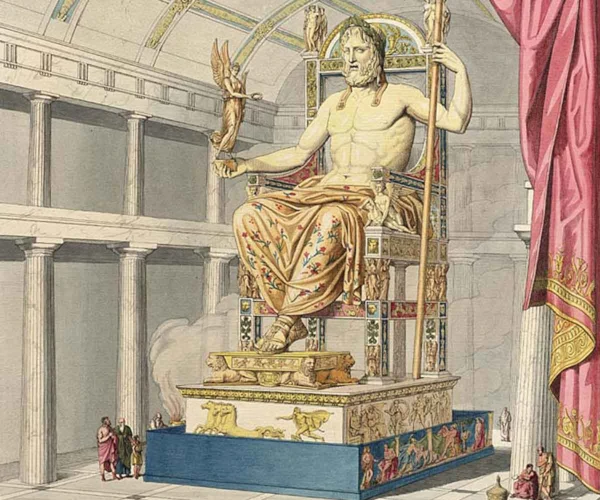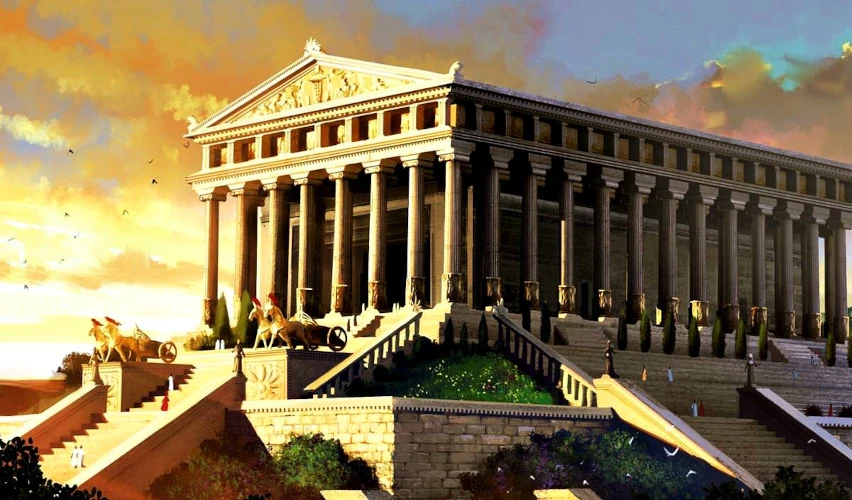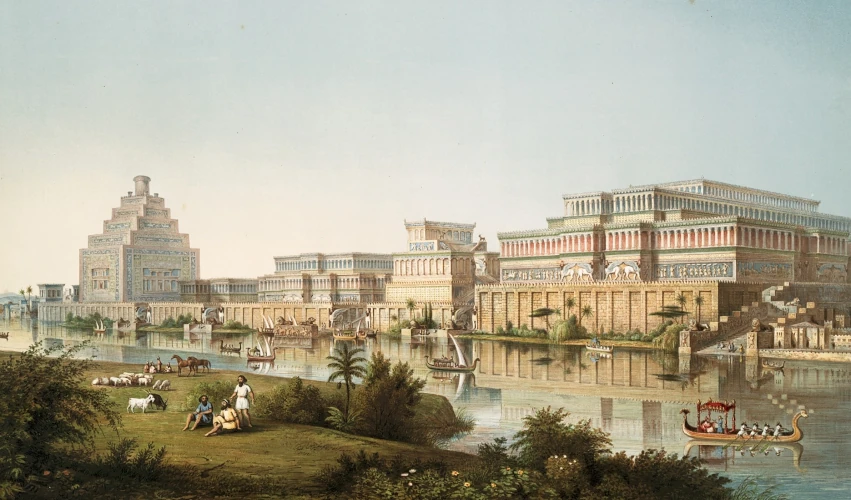The Lighthouse of Alexandria

Imagine standing at the entrance of a bustling harbor in ancient Alexandria, Egypt, and gazing up at the towering structure known as the Lighthouse of Alexandria, also called the Pharos of Alexandria. This impressive feat of engineering was built during the reign of Ptolemy II in the 3rd century BC and quickly earned its place among the Seven Wonders of the Ancient World.
With its innovative design and imposing size, the Lighthouse of Alexandria stood as a testament to the ingenuity and skill of ancient architects and engineers. However, despite its fame and grandeur, the Lighthouse of Alexandria is not as well-known today as some of its fellow ancient wonders, such as the Pyramids of Giza or the Hanging Gardens of Babylon. This is due in part to the fact that the structure was eventually destroyed by a series of earthquakes in the 14th century AD, leaving behind little more than historical accounts and artistic depictions.
The Lighthouse of Alexandria remains a fascinating piece of ancient history that captures the imagination and sparks the curiosity of all who learn about it. Its technological innovations and contributions to lighthouse design are still remembered and celebrated today, serving as a testament to the enduring legacy of the ancient world.
The Walls of Babylon

Imagine standing at the base of the Walls of Babylon, towering fortifications that surrounded the ancient city of Babylon in Mesopotamia. Built by the powerful Babylonian king Nebuchadnezzar II in the 6th century BC, these walls were some of the most impressive fortifications of the ancient world.
The Walls of Babylon were made of baked bricks and reinforced with layers of bitumen and reeds, creating an almost impenetrable barrier against invading armies. Guard towers and gates were strategically placed throughout the walls, making them virtually impregnable. So impressive were these walls that they inspired the phrase “a wall like the walls of Babylon” to describe any exceptionally strong and unassailable fortification.
Despite their remarkable size and strength, the Walls of Babylon are not as well-known today as some of the other ancient wonders, such as the Pyramids of Giza or the Colossus of Rhodes. The walls suffered significant damage over time, with many of their bricks being repurposed for other building projects throughout the region. However, the Walls of Babylon continue to inspire admiration and wonder among scholars and history buffs, serving as a testament to the power and ingenuity of the ancient world.
The Statue of Zeus at Olympia

Behold the magnificent masterpiece of ancient Greek art and sculpture - The Statue of Zeus at Olympia! Created in the 5th century BC by the legendary sculptor Phidias, this awe-inspiring statue portrayed the mighty god Zeus sitting on his throne, adorned with ornate drapery and holding a scepter in one hand and a statue of Nike, the goddess of victory, in the other. Standing tall at over 40 feet and crafted entirely of ivory and gold, it was one of the most expensive works of art in its time.
The Temple of Zeus at Olympia was the proud home of this religious icon, drawing pilgrims from all over Greece to behold its majestic presence. Considered one of the Seven Wonders of the Ancient World, the statue shared the spotlight with other notable structures like the Hanging Gardens of Babylon and the Lighthouse of Alexandria.
However, the statue’s fate was not a happy one. During the fall of the Western Roman Empire in the 5th century AD, the temple housing the statue was destroyed, and the statue itself was either destroyed or melted down for its precious metals.
Despite the tragic end of this magnificent statue, its legacy lives on through its impact on ancient Greek culture and art. Historians and art enthusiasts alike continue to study and celebrate its greatness, cementing its place as one of the greatest artistic achievements of the ancient world. Though its remains may be lost, its grandeur will always be remembered.
The Mausoleum at Halicarnassus

The Mausoleum at Halicarnassus was a true masterpiece of ancient architecture, constructed as an extravagant tomb for Mausolus, the Carian ruler of Asia Minor. This grand structure was a collaborative effort of four renowned Greek architects: Pythius, Satyrus, Bryaxis, and Timotheus, each contributing their unique expertise to create a masterpiece of monumental proportions.
Not only was the Mausoleum impressive in its size, but its intricate and ornate details were also a sight to behold. The structure boasted of intricate sculptures, including chariots and horses, and a pyramid-like roof adorned with a life-sized sculpture of Mausolus and his wife Artemisia.
The Mausoleum’s magnificence attracted visitors from far and wide and was hailed as one of the Seven Wonders of the Ancient World, alongside other remarkable structures such as the Great Pyramid of Giza and the Hanging Gardens of Babylon.
Despite being ravaged by earthquakes over the centuries, the legacy of the Mausoleum lives on. Its unique architectural style has inspired many other grand tombs and buildings throughout history, including the magnificent St. Peter’s Basilica in Rome. While it may not be as famous today as other ancient wonders, the Mausoleum at Halicarnassus remains a testament to the ingenious minds of the ancient world’s architects and builders, and their ability to create enduring works of art and engineering.
The Temple of Artemis at Ephesus

The Temple of Artemis at Ephesus was more than just a temple - it was a breathtaking display of the power of religious devotion and the ingenuity of ancient architects. Dedicated to the goddess Artemis, the temple was a marvel of engineering, art, and faith. Situated in the ancient city of Ephesus, which is now modern-day Turkey, this magnificent temple was one of the largest ever constructed in the ancient world.
Over the centuries, the temple underwent numerous transformations, starting with a simple wooden structure built in the 8th century BC. The temple was later destroyed by arson and rebuilt in a grander form, only to suffer the same fate again. However, with each destruction, the temple was rebuilt with even more grandeur and magnificence.
At its height, the temple was adorned with over 100 marble pillars, each over 60 feet tall, and was supported by a foundation of solid marble. The temple also boasted of intricate sculptures and carvings, including reliefs depicting scenes from the life of Artemis.
The Temple of Artemis was more than just a religious structure - it was a symbol of power, wealth, and cultural sophistication. The temple was a major attraction, drawing visitors from all over the ancient world to marvel at its sheer size and beauty.
Despite its grandeur and religious significance, the temple suffered damage from multiple earthquakes and invasions over the centuries. It was finally abandoned in the 5th century AD, and its materials were plundered and repurposed for other constructions.
While not as well-known today as other ancient wonders, the Temple of Artemis at Ephesus remains a testament to the devotion and ingenuity of the ancient world’s architects and builders. Its grandeur and influence can be seen in many other monumental religious buildings throughout history, such as the Hagia Sophia in Istanbul, Turkey. Even though the temple is now in ruins, its legacy lives on as a testament to the incredible achievements of the ancient world.
The Colossus of Rhodes

The Colossus of Rhodes was a remarkable feat of ancient engineering and artistry. Commissioned by the people of Rhodes to honor their patron god Helios, the statue was a towering masterpiece that stood over 30 meters tall. It was erected at the entrance of the harbor of Rhodes, where it greeted visitors and served as a symbol of the city’s power and wealth.
Constructed over a span of twelve years by the sculptor Chares of Lindos, the statue was made of bronze and iron and was filled with stone and rubble to support its weight. Its design was so advanced that it was said to have taken Chares and his team of craftsmen years to perfect.
Despite its grandeur, the statue suffered a tragic fate when it was destroyed by a powerful earthquake in 226 BC. Although attempts were made to rebuild it, the project was eventually abandoned due to the cost and complexity of the task.
While the Colossus of Rhodes may not be as well-known today as other ancient wonders, its legacy lives on in the art and culture of the ancient world. It inspired many other monumental statues and sculptures throughout history, such as the Statue of Liberty in New York City. And although the original statue may be lost to time, its memory endures as a testament to the ingenuity and creativity of the ancient world’s artists and architects.
The Hanging Gardens of Nineveh

The Hanging Gardens of Nineveh were more than just a series of terraced gardens; they were a botanical masterpiece that reflected the sophistication and ingenuity of the ancient world. King Sennacherib of Assyria created these gardens in the 7th century BCE in the city of Nineveh, which is located in modern-day Iraq. The gardens were irrigated by a complex system of water channels and pumps that brought water from the nearby mountains to the terraced levels.
Sennacherib built the Hanging Gardens to bring happiness to his queen, who was homesick for the lush greenery of her homeland. The gardens were renowned for their beauty and complexity, and were regarded as one of the Seven Wonders of the Ancient World. Visitors marveled at the vast array of plants and greenery on display, which were carefully curated to create a stunning visual spectacle.
Despite their fame and popularity, the exact location of the Hanging Gardens is still debated among historians and archaeologists. Sadly, the gardens have not been as well preserved as other ancient wonders, and their precise details and design remain a mystery. It is believed that they were destroyed by invading armies in the 2nd century BCE, and their ruins have since been lost to history.
The Hanging Gardens of Nineveh remain a symbol of human creativity and the beauty of nature. Their legacy has inspired many other garden designs throughout history, and their story continues to capture the imagination of people all over the world.